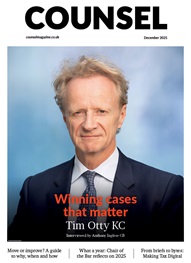*/
Clarity for Lawyers: Effective Legal Language (3rd edition)
Authors: Mark Adler and Daphne Perry
Publisher: Law Society, 270pp
ISBN: 978-1784460488
This a very enjoyable, practical and persuasive guide for any lawyer who wants to improve their use of language. Indeed, as Lord Neuberger writes in his foreword, ‘anyone who is engaged in communication, whether in writing or by word of mouth, could profit from reading this book’.
The book is divided into five parts. It begins by analysing what is wrong with traditional legal writing, using everyday examples and demonstrating how legalese alienates judges, clients and the public. The second part highlights the aims of a legal writer before looking at what exactly plain language is and why it matters. The third part provides practical guidance on how to make your writing more effective, including how to organise and format your documents.
Chapters on key rules of punctuation and grammar include salutary lessons on the effects of getting them wrong: eg ‘For want of a comma, we have this case’ (O’Connor v Oakhurst Dairy, No. 16-901, 1st Cir. 2017). The use of modern computer software is considered. The fourth part of the book analyses how misunderstandings, vagueness, ambiguity, and misleading expectations can all easily be generated. The final part summarises the common law rules of interpretation.
The appendices are helpful; a legal writing workshop, with sample practical exercises in contract drafting; worked examples of revisions being made to solicitor’s correspondence, opinions, etc; and various precedents.
As a Law Society publication, it naturally leans more towards the work of solicitors but barristers will also benefit from the guidance provided.
The US federal judge, Elijah Barrett Prettyman, famously said that ‘the lawyer’s greatest weapon is clarity, and its whetstone is succinctness’ (cited by Herbert F Goodrich, A Case on Appeal – A Judge’s View; Appeals (American Law Institute,1952, p 6). This book will help any lawyer who wants to achieve both.
Reviewer: Michael McParland QC, Commercial Silk at Quadrant Chambers
This a very enjoyable, practical and persuasive guide for any lawyer who wants to improve their use of language. Indeed, as Lord Neuberger writes in his foreword, ‘anyone who is engaged in communication, whether in writing or by word of mouth, could profit from reading this book’.
The book is divided into five parts. It begins by analysing what is wrong with traditional legal writing, using everyday examples and demonstrating how legalese alienates judges, clients and the public. The second part highlights the aims of a legal writer before looking at what exactly plain language is and why it matters. The third part provides practical guidance on how to make your writing more effective, including how to organise and format your documents.
Chapters on key rules of punctuation and grammar include salutary lessons on the effects of getting them wrong: eg ‘For want of a comma, we have this case’ (O’Connor v Oakhurst Dairy, No. 16-901, 1st Cir. 2017). The use of modern computer software is considered. The fourth part of the book analyses how misunderstandings, vagueness, ambiguity, and misleading expectations can all easily be generated. The final part summarises the common law rules of interpretation.
The appendices are helpful; a legal writing workshop, with sample practical exercises in contract drafting; worked examples of revisions being made to solicitor’s correspondence, opinions, etc; and various precedents.
As a Law Society publication, it naturally leans more towards the work of solicitors but barristers will also benefit from the guidance provided.
The US federal judge, Elijah Barrett Prettyman, famously said that ‘the lawyer’s greatest weapon is clarity, and its whetstone is succinctness’ (cited by Herbert F Goodrich, A Case on Appeal – A Judge’s View; Appeals (American Law Institute,1952, p 6). This book will help any lawyer who wants to achieve both.
Reviewer: Michael McParland QC, Commercial Silk at Quadrant Chambers
Clarity for Lawyers: Effective Legal Language (3rd edition)
Authors: Mark Adler and Daphne Perry
Publisher: Law Society, 270pp
ISBN: 978-1784460488


Chair of the Bar reflects on 2025
Q&A with criminal barrister Nick Murphy, who moved to New Park Court Chambers on the North Eastern Circuit in search of a better work-life balance
Revolt Cycling in Holborn, London’s first sustainable fitness studio, invites barristers to join the revolution – turning pedal power into clean energy
Rachel Davenport, Co-founder and Director at AlphaBiolabs, reflects on how the company’s Giving Back ethos continues to make a difference to communities across the UK
By Marie Law, Director of Toxicology at AlphaBiolabs
AlphaBiolabs has made a £500 donation to Sean’s Place, a men’s mental health charity based in Sefton, as part of its ongoing Giving Back initiative
Are you ready for the new way to do tax returns? David Southern KC explains the biggest change since HMRC launched self-assessment more than 30 years ago... and its impact on the Bar
Professor Dominic Regan and Seán Jones KC present their best buys for this holiday season
Oscar Davies shares their lessons learnt
Little has changed since Burns v Burns . Cohabiting couples deserve better than to be left on the blasted heath with the existing witch’s brew for another four decades, argues Christopher Stirling
Pointillism, radical politics and social conscience. Review by Stephen Cragg KC